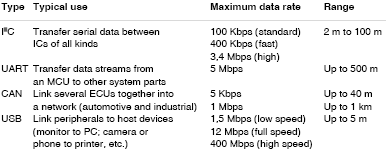
Whether for passing messages between chips or sharing information between appliances, efficient and cost-effective wired connectivity is essential to the performance and saleability of virtually every electronic product.
As part of an extensive wired connectivity portfolio, Philips Semiconductors specialises in four key technologies - I²C, UARTs, CAN and USB - and has built an impressive track record through continued innovation.
I²C
Invented by Philips in the early 1980s, the Inter-IC (I²C) bus has become the de facto worldwide standard for system control. It can be found in everything from temperature monitors and voltage level translators through EEPROMs and general-purpose I/Os to data converters, CODECs and microprocessors. A simple two-wire bus with a software-defined protocol, it is used to transfer data between ICs of all kinds over distances up to one hundred metres.
One of the keys to the enduring success of the I²C bus is the way its performance has kept pace with changing market demands. Today, three data transfer modes are available: standard (100 Kbps), fast (400 Kbps) and high-speed (3,4 Mbps). In addition, Philips recently introduced hubs, repeaters, bi-directional switches and multiplexers that have extended the capacity of the I²C bus far beyond its original 400 pF maximum capacitive bus loading limit.
The ease of use of the I²C bus has also added to its popularity. Any I²C device can be attached to a common I²C bus, and any master device can interact with any slave. The software-controlled addressing scheme eliminates the need for address-decoding hardware, while control logic is provided by the bus protocol. Furthermore, the latest generation of I²C devices supports hot insertion, minimising downtime when maintaining or expanding a system.
Some I²C-based families Philips offers: ADCs; parallel bus to I²C bus controllers; I²C bus repeaters, hubs and extenders; EEPROM-based DIP switches; LED dimmers/blinkers; general-purpose quasi and true I/O; multiplexers and switches; I²C serial EEPROM; temperature and voltage sensors; voltage level translators.
UARTs
The universal asynchronous receiver/transmitter (UART) first appeared on the market in the late sixties and offers data rates up to 5 Mbps with a maximum range of 500 m. With its low cost, long lifetime and ease of use, it is still widely regarded as the best way to transfer data from a microcontroller to other parts of the system and is extensively used for this purpose.
Philips has considerable experience in UART development, and is a leading supplier of industrial UARTs. Its extensive portfolio includes families of pin-compatible devices, offering drop-in upgrades to higher speeds, deeper FIFOs, etc. And to meet the demand for more functionality from smaller end products, the company has developed a new UART range specifically for space-constrained applications. These tiny devices deliver space savings of up to 70%, typically without requiring the redesign of the PCB.
Some UART families Philips offers: industrial UARTs (SC28xxx); SC16CxxxB UARTs; Impact range.
CAN
Originally developed for in-vehicle networking systems, the control area network (CAN) bus is also now increasingly common in industrial and medical applications. Used to link electronic control units (ECUs) together to form networks, it offers data transfer up to 1 Mbps over distances up to 40 m, or 5 Kbps for longer distances up to 1 km. A choice of three physical layer options is available to meet the demands of various applications: high-speed CAN (HS-CAN) for the highest data rates, fault-tolerant CAN (FT-CAN) for maximum reliability, and single-wire CAN (SW-CAN) for cost-down applications.
Philips has long been a leader in CAN, and its PCA82C250 is still one of the most widely-used CAN transceivers. The company has one of the widest CAN portfolios on the market, with extensive packaging options to fit any design. But Philips does more than just offer baseline compliance, and is continually expanding an impressive array of added-value products and innovations that have already become industry standards.
Some CAN families Philips offers: standalone CAN 2.0B controllers; 8-, 16- and 32-bit microcontrollers with embedded CAN; automotive- and industrial-grade transceivers for HS-, FT-, and SW-CAN.
USB
The universal serial bus (USB) is the world's most popular interface for high-speed data transfer between PCs and peripherals such as printers and digital cameras. It offers three data rates: low speed (up to 1,5 Mbps), full speed (up to 12 Mbps) and high speed (up to 400 Mbps). With ever-easier access to services and the ability to create their own content, consumers also want to be able to share this material between devices and with friends. USB provides a convenient and familiar way to deliver this, and so is an attractive addition to many products.
Philips has been heavily involved in USB from the start and helped drive two recent technological developments to expand its potential even further. With its low power consumption and small form factor connectors, USB on-the-go (OTG) was designed to extend the applicability of USB 2.0 in the portable domain. It enables 'peer-to-peer' communication by equipping peripheral devices with limited host capabilities. This allows consumers to transfer data from, say, their camera to their mobile phone without the need for a PC host.
The UTMI+ low pin interface (ULPI) provides a standard 12-pin interface between a USB 2.0 transceiver and the USB logic embedded within complicated ICs. It allows designers to offer greater USB functionality while reducing time-to-market and end-product size. Furthermore, it ensures interoperability between transceivers.
Besides being instrumental in developing the ULPI and OTG standards, Philips was the first company to offer semiconductor solutions that meet them. However, Philips' USB offering is not only about hardware. Comprehensive support tools include mature USB software - working with any operating system, the software offers a proven platform for rapid design-in. For example, the software for USB 2.0 supports WinCE, Linux, Symbian,VxWorks, æITRON and Nucleus. Philips also provides firmware and software stacks, evaluation kits and example applications, reference designs and tutorials, etc to simplify the designer's job.
Some USB families Philips offers: hub controllers; host controllers; peripheral controllers; transceivers; OTG controllers; ULPI transceivers.


© Technews Publishing (Pty) Ltd | All Rights Reserved